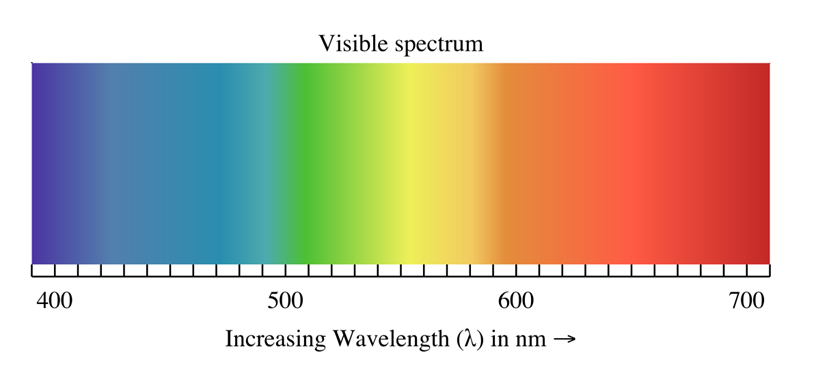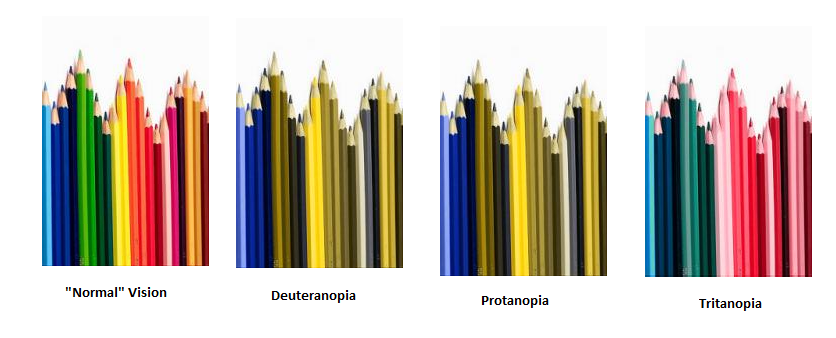Dorothy in the Wizard of Oz sang of trees of green. Or where they red? If you're colorblind, you may not be sure. When we imagine how a color-blind person sees the world, we may picture something like the dusty Kansas landscapes before Dorothy travels over the rainbow to the colorful world that houses the Emerald City. That all changed when I actually met a color blind person who informed me it's not all black and white (pun intended).
My boyfriend has deuteranopia, a type of red/green colorblindness. As a result, he often confuses reds/greens/browns, blues/purples, and pinks/grays. This meant he got in trouble in school for coloring a volcano green instead of brown. Today, this means I can convince him the gray shirt he's wearing is actually pink. So what does the world actually look like for him? This website allows you to add a “color-blind†filter to images. Apply this filter to the Wizard of Oz scenario, and the Emerald city is now the Brownish-Yellow city, and the illustrious Ruby Slippers have a sad grayish-yellow hue. Instagram probably won't be adopting this filter anytime soon.

This altered color perception is the result of missing a light receptor in the eye called a cone. You can think of cone cells like the wireless receiver in your laptop: much like how the wireless receiver converts radio waves into a format you can understand, like the text on your screen, cone cells receive light waves and convert them into signals your brain can understand, namely color.

Although humans have millions of cones in their eyes, there are only 3 types of cones. In the trichromatic color theory, each type of cone detects either short, medium or long wavelengths of light, and are aptly named S, M, and L cones respectively. Each wavelength of light a cone detects corresponds to a color. For example, when long wavelengths of light stimulate L cones you see red. You see green when medium wavelengths are stimulated by M cones, and blue results from short wavelengths hitting S cones. The proportion of each type of cone that is stimulated determines the color you see.

Those with deuteranopia, like my boyfriend, are missing the M cone and cannot process green light. Without being able to see green it's understandable that he would mistake a green colored pencil for brown. But why does he think a pink shirt is gray and why do the Ruby Slippers lose their eponymous color?
To answer this question, stare at the diamond in the middle of one of the hearts below for 10 seconds. Now look at the diamond in the white heart next to it. What color do you see?
Across from the red heart you probably saw green, and across from the blue heart you might have seen yellow.This phenomenon, known as the Opponent Process Theory, states that another type of cell, the ganglion cell, processes the stimulus from the cones in opposing color-pairs: blue/yellow and red/green. Ganglion cells are the signaling cell of the optic nerve and can only submit signals about one of the colors in the opposing color pairs to the brain at a time. Red/green is processed as a ratio of L cone to M cone stimulation. Without the M cone, the ganglion cells cannot process the signal correctly, leading to deficiency in both green and red perception. This defect in red perception means that any color that contains reds will appear as if the red is absent, causing pinks to appear gray and purples to appear blue.
The same principle applies to protanopia, another form of red/green colorblindness resulting from the absence of L cones and the inability to process the red component of red/green vision. Similarly, tritanopia blue/yellow colorblindness results from the absence of S cones and the inability to process blue light. As a whole, these conditions are called dichromacy because only two cones are present.

Image created by author.
You don't have to have a missing cone to have color deficiency. Conditions where all the cones are present but may not be fully functional, are known as anomalous trichromacy. Defective M, L, or S cones results in less severe forms of color deficiency known as deuteranomaly, protanomaly and tritanomaly respectively.
While red/green color deficiency is the most common form of color-blindness, affecting 8% of males, people who see the world through the real life Willow Instagram Filter do exist. These people have only one type of cone cell, or no cone cells at all, resulting in a complete lack of color vision. My boyfriend's maternal grandfather actually is one of these monochromats.

Recently there has been attention on people called tetrachromats, who have four cones. Tetrachromats are usually women because a woman has two X-chromosomes that carry her genetic information (as opposed to males who have an X-chromosome and a Y-chromosome). Tetrachromacy can happen if a daughter inherits a “normal†set of L,M,and S cones on the X-chromosome from a normal vision mom but a set of cones with L,S and a mutated M (m) on the X-chromosome from a dad with deuteranomaly. Because of X-inactivation (the same phenomenon that causes calico coats in cats), each of her cone cells will essentially choose which copy of the X-chromosome it will have active. Therefore, her cone cells either express the normal L, the normal S, the normal M, or the dysfunctional m. Although this won't allow her to see infrared light like some other animals that have 4 cones, it might make her a really good artist by allowing her to see more shades of color when light stimulates all 4 cones. Unfortunately, a tetrachromat isn't in the cards for my future family since my boyfriend is completely missing the M cone.
For those with certain types of colorblindness, the advent of recent technology might allow them to see the full spectrum of colors, but my boyfriend is not that worried about it. He may have to buy colored pencils that are explicitly labeled with the color, or double check his clothes before he leaves the house. However, his biggest inconvenience is probably being asked the question “what color is this to you?†For those of us with normal color vision, we think he sees the world in shades of muted blues and yellows, but for him and others that grow up colorblind, a small difference in shade can mean the difference between Kansas and the land over the rainbow. Their rainbow may be a little different from ours, but to them, their world is just as colorful as anyone else's.
About the Author
 Megan Prescott is a Ph.D candidate in the Department of Microbiology at the University of Georgia. She dedicates her time outside the lab to serving as President of UGA's Women in Science (WiSci) organization, volunteering with the Junior League of Athens, and continuously watching The Office on Netflix. She counts each day she leaves the lab without giving herself TB as a success. More from Megan Prescott. Megan Prescott is a Ph.D candidate in the Department of Microbiology at the University of Georgia. She dedicates her time outside the lab to serving as President of UGA's Women in Science (WiSci) organization, volunteering with the Junior League of Athens, and continuously watching The Office on Netflix. She counts each day she leaves the lab without giving herself TB as a success. More from Megan Prescott. |
About the Author
- athenssciencecafehttps://athensscienceobserver.com/author/athenssciencecafe/April 17, 2020
- athenssciencecafehttps://athensscienceobserver.com/author/athenssciencecafe/April 12, 2020
- athenssciencecafehttps://athensscienceobserver.com/author/athenssciencecafe/April 3, 2020
- athenssciencecafehttps://athensscienceobserver.com/author/athenssciencecafe/March 30, 2020







